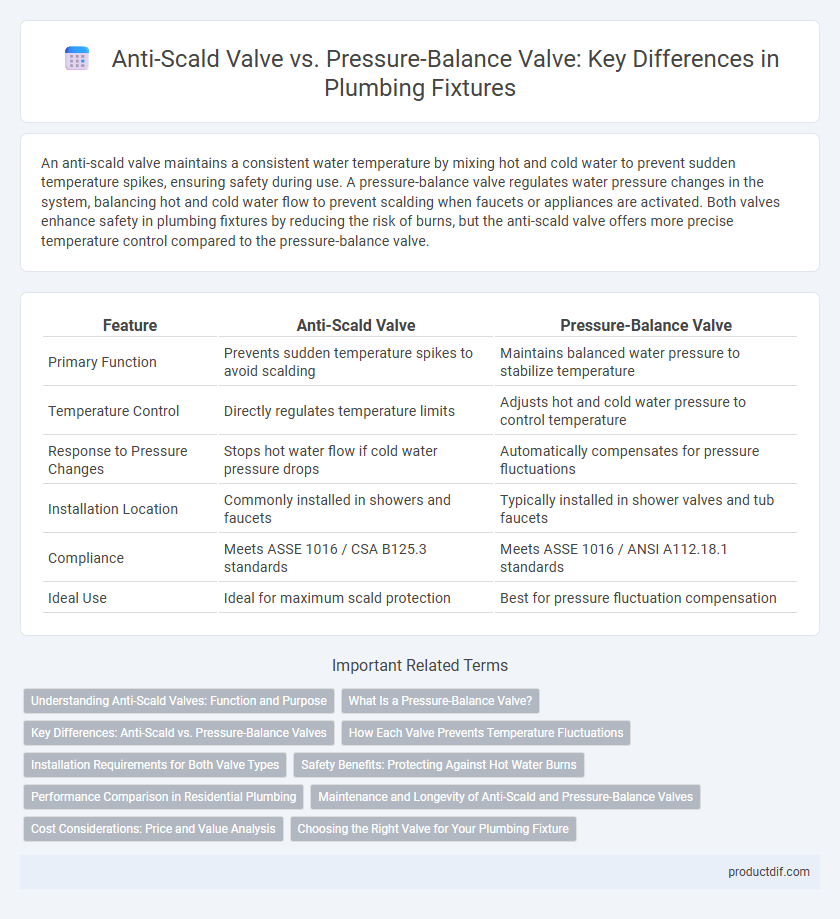An anti-scald valve maintains a consistent water temperature by mixing hot and cold water to prevent sudden temperature spikes, ensuring safety during use. A pressure-balance valve regulates water pressure changes in the system, balancing hot and cold water flow to prevent scalding when faucets or appliances are activated. Both valves enhance safety in plumbing fixtures by reducing the risk of burns, but the anti-scald valve offers more precise temperature control compared to the pressure-balance valve.
Table of Comparison
| Feature | Anti-Scald Valve | Pressure-Balance Valve |
|---|---|---|
| Primary Function | Prevents sudden temperature spikes to avoid scalding | Maintains balanced water pressure to stabilize temperature |
| Temperature Control | Directly regulates temperature limits | Adjusts hot and cold water pressure to control temperature |
| Response to Pressure Changes | Stops hot water flow if cold water pressure drops | Automatically compensates for pressure fluctuations |
| Installation Location | Commonly installed in showers and faucets | Typically installed in shower valves and tub faucets |
| Compliance | Meets ASSE 1016 / CSA B125.3 standards | Meets ASSE 1016 / ANSI A112.18.1 standards |
| Ideal Use | Ideal for maximum scald protection | Best for pressure fluctuation compensation |
Understanding Anti-Scald Valves: Function and Purpose
Anti-scald valves regulate water temperature by blending hot and cold water to prevent sudden temperature fluctuations, ensuring consistent and safe water output. These valves are essential in protecting users from burns caused by unexpected hot water surges, especially in showers and faucets. Unlike pressure-balance valves that respond mainly to pressure changes, anti-scald valves maintain precise temperature control for enhanced safety and comfort.
What Is a Pressure-Balance Valve?
A pressure-balance valve regulates water temperature by maintaining equal pressure between hot and cold water lines, preventing sudden temperature fluctuations during usage. Unlike anti-scald valves that primarily limit maximum temperature, pressure-balance valves adjust both pressure and flow to protect against scalding from abrupt changes in water pressure. Commonly installed in shower systems, these valves enhance user safety and comfort by ensuring stable temperature control.
Key Differences: Anti-Scald vs. Pressure-Balance Valves
Anti-scald valves maintain consistent water temperature by regulating both hot and cold water to prevent sudden temperature spikes, whereas pressure-balance valves adjust water flow to balance pressure changes but do not control temperature as precisely. Anti-scald valves often include thermostatic control for enhanced safety, while pressure-balance valves rely on mechanical means to prevent scalding caused by pressure fluctuations. Installing an anti-scald valve is ideal for locations requiring strict temperature regulation, whereas pressure-balance valves are suitable for general protection against sudden cold water loss.
How Each Valve Prevents Temperature Fluctuations
Anti-scald valves prevent temperature fluctuations by automatically adjusting the mix of hot and cold water when a pressure change occurs, maintaining a safe and consistent temperature. Pressure-balance valves use a mechanical diaphragm or piston to detect sudden pressure drops in either hot or cold water lines, instantly regulating the flow to prevent scalding or thermal shock. Both valves ensure user safety by stabilizing water temperature despite varying water pressures in plumbing systems.
Installation Requirements for Both Valve Types
Anti-scald valves require precise temperature settings and connection to both hot and cold water lines to ensure consistent temperature regulation, often necessitating installation in accessible areas for maintenance. Pressure-balance valves demand integration within the water supply system to balance pressure fluctuations, typically installed behind the shower control or tub spout with proper access for calibration. Both valve types mandate compliance with local plumbing codes and may require professional installation to guarantee optimal performance and safety.
Safety Benefits: Protecting Against Hot Water Burns
Anti-scald valves provide precise temperature regulation by automatically adjusting water temperature to prevent sudden spikes, significantly reducing the risk of hot water burns. Pressure-balance valves maintain consistent water pressure between hot and cold lines, minimizing temperature fluctuations during pressure changes but may be less precise than anti-scald valves. Both valves enhance safety in plumbing fixtures, with anti-scald valves offering superior protection against scald injuries in residential and commercial settings.
Performance Comparison in Residential Plumbing
Anti-scald valves provide precise temperature control by instantly adjusting hot and cold water flow to prevent sudden temperature spikes, ensuring user safety and comfort in residential plumbing. Pressure-balance valves maintain consistent water pressure by balancing fluctuations in hot and cold water supply, reducing the risk of scalding during pressure drops but with less precise temperature regulation. Performance comparison highlights anti-scald valves as superior for accurate temperature stability, while pressure-balance valves offer reliable pressure compensation for general residential use.
Maintenance and Longevity of Anti-Scald and Pressure-Balance Valves
Anti-scald valves require regular inspection and cleaning to prevent mineral buildup and ensure precise temperature regulation, enhancing their longevity. Pressure-balance valves generally need less maintenance but can suffer from wear in the internal diaphragm or cartridge, necessitating timely replacement for consistent performance. Both valve types benefit from routine maintenance to maximize lifespan and maintain reliable temperature control in plumbing systems.
Cost Considerations: Price and Value Analysis
Anti-scald valves typically have a higher upfront cost compared to pressure-balance valves due to their advanced temperature control technology. Pressure-balance valves offer a more affordable option, providing reliable protection by maintaining consistent water pressure to prevent sudden temperature spikes. When evaluating cost and value, anti-scald valves deliver enhanced safety features that justify the investment in settings with higher risk, while pressure-balance valves suit budget-conscious installations with moderate protection needs.
Choosing the Right Valve for Your Plumbing Fixture
Selecting the right valve for your plumbing fixture ensures safety and comfort by preventing sudden temperature fluctuations. Anti-scald valves regulate hot water temperature to a preset limit, providing precise protection against burns, while pressure-balance valves maintain water temperature by balancing pressure changes between hot and cold water supplies. Consider the specific fixture requirements and local plumbing codes when choosing between anti-scald and pressure-balance valves to optimize performance and safety.
anti-scald valve vs pressure-balance valve Infographic

 productdif.com
productdif.com